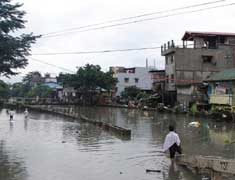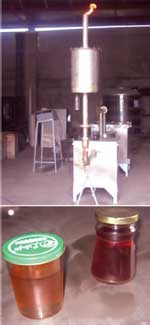Also, download this story from the electronic issue here
The Philippines’s waste disposal problem continues to persist, with plastic bags making up a bulk of the rubbish, say environment watchdogs. This is despite the plastic bag ban enforced in the country in 2011. Has the system failed or is it time to switch strategies by raising awareness to reuse and recycle, asks Angelica Buan in this article.
Plastics have been portrayed as a Jekyll and Hyde syndrome – being useful but at the same time with potential risks to the environment and human health. In the Philippines, where flooding is becoming a perennial phenomenon, plastic bag wastage is mostly in the limelight when the issue of rubbish that blocks waterways is raised.
The magnitude of the waste problem in the country is captured in the “Garbage Book”, published by the Asian Development Bank (ADB) in 2004. It said that in Metro Manila, the nation’s capital, about 1,500 tonnes/ day of waste is thrown into dumpsites, creeks and rivers. Compounding the mounting waste disposal was the lack of recycling and waste disposal systems.

Meanwhile, the National Solid Waste Management Commission and Strategy (NSWMCS) says that in 2010, the Philippines generated 35,000 tonnes of waste, with Metro Manila alone (which accounts for a fourth of the waste output in the country), producing nearly 9,000 tonnes/day of waste.
Of the country’s total waste output, 16% was accounted for by plastics, according to the Metro Manila Development Authority (MMDA). The latter agency, which has initiated a quarterly clean-up drive to de-clog open waterways, said that it collected an estimated 7,190 cu m of waste from 15 waterways, mostly plastics and styrofoam packaging.
In the recent months that Metro Manila has been barraged by floods, control remedies, specifically the wide-scale plastic bag ban put in place at the call of environmental groups in 2011, seem to have fallen short of serving their purpose.
Plastic bag ban – boon or bane?
“The wide-scale ban and regulations for plastic bags are still on-going,” said Teo Kee Bin, President of the Philippine Plastics Industry Association (PPIA), who spoke to PRA at the recent PrintPackPlas show held 9-11 October at SMX, Pasay City, Philippines.
The PPIA has been vocal about its position against the implementation of the plastic bag ban from the start. It had said that plastic bags, per se, are not to be blamed for the flooding but the public’s untoward disposal of garbage such as used plastic bags. “The ban is a popular measure,” said Teo, who is also the General Manager of Manila-headquartered plastics products maker Plastimer, when asked if the ban would be repealed.
The amount of used plastic bags that are discarded remains a discussion piece, and for which Teo comments that because plastic bags are cheap to purchase, end users neglect to see the value when discarding them.
On the other hand, Teo opines that the industry has also neglected to educate the public on how to reuse plastic bags, at the onset of plastics becoming a staple means of packaging.
Nevertheless, while the ban affects sales and manufacturing capacities of local plastic bag makers, it is far from crippling this segment of the industry.
‘There is no better substitute (as yet) for plastic bags,” according to Teo. “Paper bags may not be suitable for certain food items like fruits, for example, and not unless the bag has a handle. Also, paper bags cost more.”
At the height of the bag ban’s momentum in 2012, the association projected the industry’s workforce to downsize by 50%.
“As it is, there are no job losses in big retail stores, which are heavily affected by the ban and the regulations. But the producers of plastic bags catering to these stores are affected,” Teo said, explaining further that shopping malls have to strictly adhere to the legislations whereas the smaller stores and retail outlets seem to be more lax in obeying regulations.
One positive thing that may have resulted from the ban is that some manufacturers have diversified to the production of paper bags, says Teo. But he adds that since the local paper industry largely imports raw materials from other countries, this diversification is not totally of benefit to the local manufacturing sector.
Currently, the association is engaged in recycling activities and advocacies to raise public awareness that plastics are indeed 100% recyclable, with proper waste disposal, segregation and recycling practices.
Plastic waste can be recycled and reused, said Teo. For instance, Bontoc, the capital municipality of Mountain Province, a landlocked province in the Cordillera region in northern Philippines, has been able to convert waste plastics and PET water bottles into building materials such as hollow blocks, which are aptly called eco-blocks and eco-bricks.
Recycling technologies at hand
A mechanical option for repurposing plastics was developed in 2004 by the Industrial Technology Development Institute (ITDI), the R&D centre of the Department of Science and Technology (DOST), in cooperation with the Packaging Council of the Philippines.
Called Plastic Styro Densifier, the technology is described as the “conversion of post-consumer waste polystyrene or styrofoam packaging materials into rigid functional products.”
The portable machine, which works like an oven with temperature and smoke emission control apparatus, melts the shredded/ground plastic waste material in vegetable oil at a controlled temperature. The liquefied material is then poured through a steel spout into moulds to produce rigid functional products such as pots, tables, wall tiles, and many more. The liquefied petroleum gas (LPG)-fired machine has a melting capacity of 60 kg per batch.
However, the commercial value of the resulting products may still be inadequate according to the ITDI, in a paper presented during the UNEP-AIST Workshop on Waste Plastics Management in 2011 in Japan. It said that limited product markets may pose uncertain commercialisation sustainability; and that the novelty products are not as competitive as conventional ones. ITDI also said the densifier may have other disadvantages such as possible health risks from gas emissions, and relatively high operating costs.
The PPIA adopted an upgraded version of this technology in 2006 for processing PE and PP waste. It also cooperated with ITDI in its other technology development, such as using plastic bag waste for processing asphalt concrete.
Waste plastics – a source of fuel
The plastic to fuel (PTF) technology is also an available solution for the country’s waste management predicament. In 2007, inventor Jayme Navarro developed a pyrolysis technology, which was the Philippines’s first PTF innovation, for producing less sulphuric diesel, LPG and gasoline with waste plastics. Navarro, who has now set up Poly-Green Technology and Resources, said that the machine he assembled is capable of processing 5,000 kg of contaminated plastics for 400 l of diesel and gasoline.
The modular-concept technology operates from 5 to 20 tonnes/day capacities with a conversion efficiency rate of 75-80% (depending on the quality of the feedstock). The process is undertaken inside a vacuum, which means no chemicals are released into the atmosphere.
Meanwhile, another local company is also engaged in making PTF machines. Suki Trading based in Lapu- Lapu City in Cebu province in southern Philippines, manufactures plastic densifiers that are said to be different from the densifier developed by the ITDI, according to proprietor Victoriano Ocon.

“Our technology originates from Germany and we are adopting the technology here in the Philippines,” Ocon told PRA in an email interview.
The 100% Philippimemade PTF technology, including the parts, is priced from Php1 million to 1.5 million.
Ocon, who is an engineer, explained that the plastics have to be shredded first, using a locally-made shredder, and then go through a heating chamber, condenser, catalyst reactor and biofilter, before conversion into fuel. The technology is able to process HDPE and PE bags as well as printed plastics. The end-product is used as crude oil and bunker fuel.
A few local government units have already bought units, Ocon said, adding that it is an eco-friendly substitute for incinerators. Yet, procurement of the technology is still low, due to “lack of awareness for recycling, as well as the local executives’ lack of desire to solve the garbage problem,” he opined.
(PRA)























